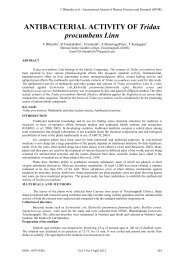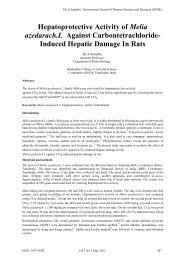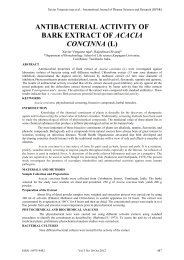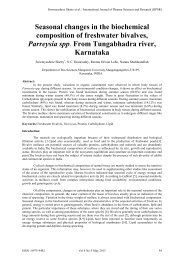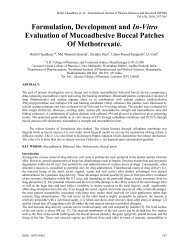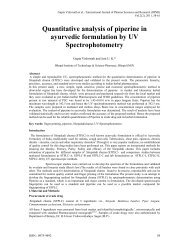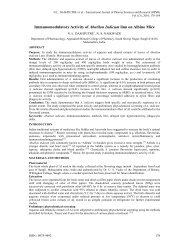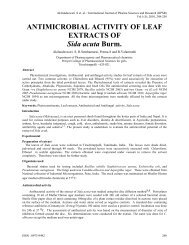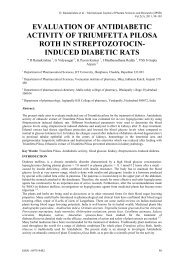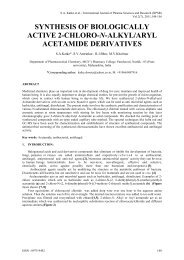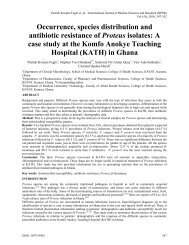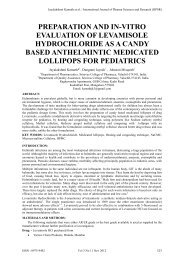spectrophotometric determination of naproxen and esomeprazole in ...
spectrophotometric determination of naproxen and esomeprazole in ...
spectrophotometric determination of naproxen and esomeprazole in ...
Create successful ePaper yourself
Turn your PDF publications into a flip-book with our unique Google optimized e-Paper software.
Neha A.Ja<strong>in</strong> et al. / International Journal <strong>of</strong> Pharma Sciences <strong>and</strong> Research (IJPSR)<br />
Vol.2(5), 2011,130-134<br />
SPECTROPHOTOMETRIC<br />
DETERMINATION OF NAPROXEN AND<br />
ESOMEPRAZOLE IN A LABORATORY<br />
MIXTURE BY SIMULTANEOUS<br />
EQUATION, ABSORPTION<br />
CORRECTION, ABSORPTION RATIO<br />
AND AREA UNDER CURVE METHODS<br />
Neha A.Ja<strong>in</strong>*, R.T.Lohiya <strong>and</strong> M.J.Umekar<br />
S.K.B. College <strong>of</strong> Pharmacy, New kamptee, Nagpur, Maharashtra, India.<br />
*Corres. author: niki_j19@yahoo.com<br />
ABSTRACT: An accurate, specific <strong>and</strong> precise UV <strong>spectrophotometric</strong> method was developed for the<br />
simultaneous <strong>determ<strong>in</strong>ation</strong> <strong>of</strong> <strong>naproxen</strong> (NP) <strong>and</strong> <strong>esomeprazole</strong> (EOZ) <strong>in</strong> a laboratory mixture <strong>of</strong> these two<br />
components. The method <strong>in</strong>volves area under curve (AUC) method <strong>in</strong> the range 227-237nm <strong>and</strong> 296.5-306.5nm<br />
respectively, formation <strong>of</strong> simultaneous equation at 232nm <strong>and</strong> 301.5nm respectively, absorption correction<br />
method at 232nm λmax <strong>of</strong> <strong>naproxen</strong>, 239.2nm isoabsorptive po<strong>in</strong>t <strong>of</strong> NP & EOZ & 301.5nm for absorption ratio<br />
method by us<strong>in</strong>g methanol as a solvent. The l<strong>in</strong>earity for both <strong>naproxen</strong> <strong>and</strong> <strong>esomeprazole</strong> was <strong>in</strong> the range <strong>of</strong> 1-<br />
5 µg/ml <strong>and</strong> 4-12µg/ml respectively. The % recovery was found to be 98.23% <strong>and</strong> 98.87% for <strong>naproxen</strong> <strong>and</strong><br />
<strong>esomeprazole</strong> respectively <strong>in</strong>dicat<strong>in</strong>g proposed method is accurate <strong>and</strong> precise for simultaneous estimation <strong>of</strong><br />
<strong>naproxen</strong> <strong>and</strong> <strong>esomeprazole</strong> <strong>in</strong> bulk formulations.<br />
KEY-WORDS: Naproxen, Esomeprazole, UV spectrophotometry, Simultaneous equation method, Absorption<br />
ratio, absorption correction method <strong>and</strong> Area under curve.<br />
INTRODUCTION<br />
Naproxen (NP) is chemically (S)-6-methoxy-α-methyl-2-naphthaleneacetic acid, is a non-steroidal anti<strong>in</strong>flammatory<br />
drug (NSAID) which is used for the treatment <strong>of</strong> severe pa<strong>in</strong> <strong>and</strong> <strong>in</strong>flammation. It acts by<br />
reduc<strong>in</strong>g the levels <strong>of</strong> prostagl<strong>and</strong><strong>in</strong>s, chemicals that are responsible for pa<strong>in</strong>, fever <strong>and</strong> <strong>in</strong>flammation. Naproxen<br />
blocks the enzyme that makes prostagl<strong>and</strong><strong>in</strong>s (cyclooxygenase), result<strong>in</strong>g <strong>in</strong> lower concentrations <strong>of</strong><br />
prostagl<strong>and</strong><strong>in</strong>s. 1,2<br />
Esomeprazole (EOZ) is chemically bis(5-methoxy-2-[(S)-[(4-methoxy-3,5-dimethyl-2<br />
pyrid<strong>in</strong>yl)methyl]sulf<strong>in</strong>yl]-1-H-enzimidazole-1-yl), a compound that <strong>in</strong>hibits gastric acid secretion.<br />
Esomeprazole is cost effective <strong>in</strong> the treatment <strong>of</strong> gastric oesophageal reflux diseases. It is S-isomer <strong>of</strong><br />
omeprazole <strong>and</strong> is the first s<strong>in</strong>gle optical isomer proton pump <strong>in</strong>hibitor. It provides better acid control than<br />
current racemic proton pump <strong>in</strong>hibitors <strong>and</strong> has a favorable pharmacok<strong>in</strong>etic pr<strong>of</strong>ile relative to omeprazole. 3,4,5<br />
Several analytical methods have been published for the <strong>determ<strong>in</strong>ation</strong> <strong>of</strong> NP <strong>in</strong> pharmaceutical preparations <strong>and</strong><br />
biological fluids. These methods <strong>in</strong>cluded first derivative non-l<strong>in</strong>ear variable-angle synchronous fluorescence<br />
spectroscopy 6 , CE with electro spray mass spectrometry 7 , HPLC 8,9 <strong>and</strong> capillary isotachophoresis 10,11 , flow<strong>in</strong>jection<br />
analysis (FIA) 12 <strong>and</strong> FIA by us<strong>in</strong>g complex formation <strong>of</strong> NAPS 13,14 .<br />
A detailed survey <strong>of</strong> literature revealed the estimation <strong>of</strong> omeprazole by gas chromatographic method 15 , UV<br />
<strong>spectrophotometric</strong> method 16,17 , TLC 18 <strong>and</strong> several HPLC 19,20 methods. However, there is no evidence <strong>in</strong><br />
literature for simultaneous <strong>determ<strong>in</strong>ation</strong> <strong>of</strong> NP <strong>and</strong> EOZ. Hence, <strong>in</strong> the present <strong>in</strong>vestigation Simultaneous<br />
ISSN : 0975-9492 130
Neha A.Ja<strong>in</strong> et al. / International Journal <strong>of</strong> Pharma Sciences <strong>and</strong> Research (IJPSR)<br />
Vol.2(5), 2011,130-134<br />
equation, Absorption correction, Absorption ratio <strong>and</strong> Area under curve methods was developed for the<br />
<strong>determ<strong>in</strong>ation</strong> <strong>of</strong> NP <strong>and</strong> EOZ <strong>in</strong> comb<strong>in</strong>ation from their laboratory mixture.<br />
MATERIALS AND METHODS<br />
Materials<br />
Naproxen <strong>and</strong> <strong>esomeprazole</strong> were supplied by Dr. Reddy’s lab as gift samples. A Jasco UV630 &<br />
Shimadzu1700 UV spectrophotometer with 1 cm matched quartz cells was used for estimation. All reagents<br />
were used <strong>of</strong> GR grade purchased from Loba chemie, Mumbai.<br />
Methods<br />
St<strong>and</strong>ard Preparation:<br />
Accurately weighed quantities (20 mg each) <strong>of</strong> NP <strong>and</strong> EOZ were dissolved separately <strong>in</strong> sufficient quantity <strong>of</strong><br />
methanol <strong>in</strong> a 50 ml volumetric flask. The volume was adjusted up to the mark with methanol to obta<strong>in</strong> a stock<br />
solution <strong>of</strong> 100 µg/ml; each <strong>of</strong> NP <strong>and</strong> EOZ.<br />
Preparation <strong>of</strong> laboratory mixture:<br />
A bulk mixture <strong>of</strong> both drugs (NP <strong>and</strong> EOZ) was prepared us<strong>in</strong>g 20 mg <strong>of</strong> NP <strong>and</strong> 20 mg <strong>of</strong> EOZ. Common<br />
excipients which are used <strong>in</strong> tablet formulation were added <strong>in</strong> this laboratory mixture, triturated well <strong>and</strong><br />
weighed. A powder equivalent to 20 mg <strong>of</strong> NP <strong>and</strong> 80 mg <strong>of</strong> EOZ was weighed accurately <strong>and</strong> transferred to<br />
100 ml <strong>of</strong> volumetric flask, dissolved <strong>in</strong> sufficient quantity <strong>of</strong> methanol <strong>and</strong> volume was adjusted up to the mark<br />
with methanol. The sample solution thus prepared was filtered through Whatman filter paper no. 44, diluted<br />
with methanol to get the solution conta<strong>in</strong><strong>in</strong>g about 1µg/ml <strong>of</strong> NP <strong>and</strong> 4µg/ml <strong>of</strong> EOZ.<br />
1<br />
0.8<br />
0.8<br />
0.6<br />
0.6<br />
Abs<br />
0.4<br />
0.4<br />
Abs<br />
0.2<br />
0.2<br />
0<br />
200 250 300 350<br />
400<br />
Wavelength [nm]<br />
0<br />
200 250 300 350<br />
400<br />
Wavelength [nm]<br />
λ max <strong>of</strong> Naproxen at 232nm<br />
λ max <strong>of</strong> Esomeprazole at 301.5nm<br />
0.6<br />
Naproxen 232nm<br />
0.4<br />
Abs<br />
0.2<br />
Isobestic Po<strong>in</strong>t<br />
At 239.2nm<br />
Esomeprazole 301.5nm<br />
0<br />
205 250 300 350<br />
400<br />
Wavelength [nm]<br />
Fig..Overla<strong>in</strong> Spectra <strong>of</strong> Naproxen & Esomeprazole show<strong>in</strong>g Abs. & AUC<br />
ISSN : 0975-9492 131
Neha A.Ja<strong>in</strong> et al. / International Journal <strong>of</strong> Pharma Sciences <strong>and</strong> Research (IJPSR)<br />
Vol.2(5), 2011,130-134<br />
Method development:<br />
For the selection <strong>of</strong> analytical wavelength for the simultaneous estimation, the stock solutions <strong>of</strong> NP <strong>and</strong> EOZ<br />
were separately diluted with methanol, to obta<strong>in</strong> the concentrations <strong>of</strong> 10μg/ml each, <strong>and</strong> scanned <strong>in</strong> the<br />
wavelength range <strong>of</strong> 200-400 nm. The λmax <strong>of</strong> NP <strong>and</strong> EOZ were found to be 232nm (λ1) <strong>and</strong> 301.5 nm (λ2)<br />
respectively. For the construction <strong>of</strong> calibration curve, st<strong>and</strong>ard solutions <strong>of</strong> NP <strong>and</strong> EOZ were diluted <strong>in</strong> the<br />
range <strong>of</strong> 1-5μg/ml <strong>and</strong> 4-12 μg/ml respectively.<br />
In Simultaneous equation method, the absorbance <strong>of</strong> the solution was measured at 232nm <strong>and</strong> 301.5nm <strong>and</strong><br />
concentration <strong>of</strong> the two drug was calculated us<strong>in</strong>g<br />
Cx=A2 ay1- A1 ay2 / ax2 ay1- ax1 ay2 (Eqn.1) <strong>and</strong><br />
Cy=A1 ax2 -A2 ax1 / ax2 ay1- ax1 ay2 (Eqn.2)<br />
Where, Cx <strong>and</strong> Cy are concentration <strong>in</strong> g/100 ml <strong>of</strong> NP <strong>and</strong> EOZ respectively.<br />
ax1 is the absorptivity <strong>of</strong> NP at 232nm, ax2 is the absorptivity <strong>of</strong> EOZ at 301.5nm,<br />
ay1 is the absorptivity <strong>of</strong> NP at 232nm, ay2 is the absorptivity <strong>of</strong> EOZ at 301.5nm.<br />
In Absorption correction method, isoabsorptive po<strong>in</strong>t was employed <strong>in</strong> which the absorbance was measured at<br />
two wavelengths, one be<strong>in</strong>g the isoabsorptive po<strong>in</strong>t <strong>of</strong> the two components <strong>and</strong> other be<strong>in</strong>g the wavelength <strong>of</strong><br />
maximum absorption <strong>of</strong> one <strong>of</strong> the two components. From the overla<strong>in</strong> spectra <strong>of</strong> two drugs absorbances were<br />
measured at selected wavelength i.e. 239.2nm isoabsorptive po<strong>in</strong>t <strong>and</strong> 301.5nm, λmax <strong>of</strong> EOZ [Figure1]. The<br />
absorbance <strong>and</strong> absorptivity values at the particular wavelengths were calculated <strong>and</strong> substituted <strong>in</strong> the<br />
follow<strong>in</strong>g equation; to obta<strong>in</strong> the concentration<br />
Cx= (Qm-Qy) /(Qx-Qy)A*ax (3) <strong>and</strong><br />
Cy= (Qm-Qx) /(Qy-Qx)A*ay (4)<br />
where, A=Absorbance <strong>of</strong> mixture at isoabsorptive po<strong>in</strong>t.<br />
Qm=Ratio <strong>of</strong> absorbance <strong>of</strong> laboratory mixture at 232nm <strong>and</strong> 301.5nm,<br />
Qx= Ratio <strong>of</strong> absorptivity <strong>of</strong> NP at 232nm <strong>and</strong> 301.5nm ,<br />
Qy= Ratio <strong>of</strong> absorptivity <strong>of</strong> PAR at 232nm <strong>and</strong> 301.5nm.<br />
In method III, Absorbance ratio method uses the absorbances at two selected wavelengths, one at λmax <strong>of</strong> one<br />
drug where other drug also shows considerable absorbance <strong>and</strong> other be<strong>in</strong>g the wavelength at which the first<br />
drug has practically nil absorbance 301.5nm is the corrected wavelength.<br />
In Area under curve method, AUC <strong>in</strong>volves the calculation <strong>of</strong> <strong>in</strong>tegrated value <strong>of</strong> absorbance with respect<br />
to the wavelength between two selected wavelength 232nm <strong>and</strong> 301.5nm (Fig). Area calculation<br />
process<strong>in</strong>g item calculates the area bound by the curve <strong>and</strong> the horizontal axis. The horizontal axis is selected<br />
by enter<strong>in</strong>g the wavelength range over which the area has to be calculated. The wavelength range is<br />
selected on the basis <strong>of</strong> repeated observations so as to get the l<strong>in</strong>earity between area under curve <strong>and</strong><br />
concentration. Suitable dilutions <strong>of</strong> st<strong>and</strong>ard stock solution (2µg/ml) <strong>of</strong> the drug were prepared <strong>and</strong><br />
scanned <strong>in</strong> the spectrum mode from the wavelength range 400-200 nm <strong>and</strong> the calibration curve was<br />
plotted. The sampl<strong>in</strong>g wavelength ranges selected for estimation <strong>of</strong> NP <strong>and</strong> EOZ are 227-237nm (λ1-λ2) <strong>and</strong><br />
296.5-306.5nm (λ3-λ4) respectively. Mixed st<strong>and</strong>ard were prepared <strong>and</strong> their Area under the Curve were<br />
measured at the selected wavelength ranges.<br />
Recovery studies were carried out at 80%, 100% <strong>and</strong> 120% level by add<strong>in</strong>g a known quantity <strong>of</strong> pure drug to the<br />
preanalyzed laboratory mixture <strong>and</strong> the proposed method was followed. From the amount <strong>of</strong> drug found,<br />
percentage recovery was calculated.<br />
RESULTS AND DISCUSSION<br />
The proposed method <strong>of</strong> simultaneous <strong>determ<strong>in</strong>ation</strong> <strong>of</strong> NP <strong>and</strong> EOZ showed absorptivity <strong>of</strong> 399.29 whereas<br />
EOZ showed absorptivity <strong>of</strong> 45.97. L<strong>in</strong>ear regression <strong>of</strong> absorbance on concentration gave equation y = 0.051x -<br />
0.036 with a correlation coefficient <strong>of</strong> 0.999 for NP <strong>and</strong> equation y = 0.319x + 0.176 with a correlation<br />
ISSN : 0975-9492 132
Neha A.Ja<strong>in</strong> et al. / International Journal <strong>of</strong> Pharma Sciences <strong>and</strong> Research (IJPSR)<br />
Vol.2(5), 2011,130-134<br />
coefficient <strong>of</strong> 0.999 for EOZ respectively. The low % RSD values <strong>of</strong> 0.414 for NP <strong>and</strong> 0.412 for EOZ were<br />
observed for analysis <strong>of</strong> 5 replicate samples, <strong>in</strong>dicat<strong>in</strong>g precision <strong>and</strong> reproducibility.NP exhibits its maximum<br />
absorption at 232nm <strong>and</strong> obeyed Beer’s law <strong>in</strong> the range <strong>of</strong> 1-5µg/ml <strong>and</strong> EOZ exhibits its maximum absorption<br />
at 301.5 nm <strong>and</strong> obeyed Beer’s law <strong>in</strong> the range <strong>of</strong> 4-12µg/ml. The results <strong>of</strong> analysis <strong>and</strong> recovery studies are<br />
presented <strong>in</strong> the Table. The percentage recovery value 98.23% <strong>and</strong> 98.87% for NP <strong>and</strong> EOZ respectively<br />
<strong>in</strong>dicates that there is no <strong>in</strong>terference from the excipients present <strong>in</strong> laboratory mixture. The developed method<br />
was found to be sensitive, accurate, precise <strong>and</strong> reproducible <strong>and</strong> can be applicable for the analysis <strong>of</strong> NP <strong>and</strong><br />
EOZ <strong>in</strong> laboratory mixtures.<br />
TABLE: Analysis <strong>of</strong> dosages forms <strong>and</strong> Recovery studies.<br />
Product Drug Labelclaim % Estimated * % RSD % Recovery† % RSD <strong>of</strong> recovery<br />
Lab NP 20 mg 100.97 0.41 98.23 1.23<br />
Mixture EOZ 80 mg 102.01 1.11 98.87 1.34<br />
NP: Naproxen; EOZ: Esomeprazole; RSD: Relative st<strong>and</strong>ard deviation;<br />
* Indicates mean <strong>of</strong> three <strong>determ<strong>in</strong>ation</strong>s (n=3);<br />
†Indicates mean <strong>of</strong> three recovery studies at 80%, 100% <strong>and</strong> 120% level.<br />
Table: Beer’s Lambert study <strong>of</strong> lab mixture<br />
Concentration Absorbance Area Under Curve<br />
2 0.057 0.5591<br />
4 0.093 0.8979<br />
6 0.145 1.4266<br />
8 0.197 1.7963<br />
10 0.234 2.298<br />
0.3<br />
0.2<br />
0.1<br />
0<br />
ABS<br />
0 5 10 15<br />
y = 0.0235x + 0.0037<br />
R² = 0.9968<br />
ABS<br />
L<strong>in</strong>ear<br />
(ABS)<br />
3<br />
2<br />
1<br />
0<br />
AUC<br />
0 5 10 15<br />
y = 0.2233x + 0.0232<br />
R² = 0.9917<br />
AUC<br />
L<strong>in</strong>ear<br />
(AUC)<br />
ACKNOWLEDGEMENTS:<br />
The authors are grateful to Dr. Reddy’s Laboratory, for provid<strong>in</strong>g gift samples <strong>of</strong> drug for research work <strong>and</strong><br />
also thankful to Pr<strong>in</strong>cipal, S.K.B.College <strong>of</strong> Pharmacy, New Kamptee for provid<strong>in</strong>g laboratory facilities <strong>and</strong><br />
constant encouragement.<br />
REFERENCES:<br />
[1] United States Pharmacopoeia <strong>and</strong> National Formulary; (24th) Asian Edition, The United States Pharmacopoeia Convention Inc,<br />
U.S.A, 2709-3259.<br />
[2] Fun, LW. (2002). MIMS Bangladesh. Medimedia, S<strong>in</strong>gapore. p. 53-67.<br />
[3] Scott LJ , Dunn CJ , Mallarkey G , Sharpe M .Esomeprazole – A review <strong>of</strong> its use <strong>in</strong> the management <strong>of</strong> acid-related disorders.<br />
Drugs 2002;62:1503-38.<br />
[4] Sean C Sweetman. Mart<strong>in</strong>dale-The completer drug reference. 2002, 33 rd edition: 1225.<br />
[5] Estimation <strong>of</strong> Esomeprazole <strong>and</strong> Domperidone by absorption ratio method <strong>in</strong> Pharmaceutical Dosage by Priti D Trivedi <strong>and</strong> Dilip G<br />
Maheshwari * <strong>in</strong> International Journal <strong>of</strong> ChemTech Research <strong>in</strong> Vol.2, No.3 July-Sept 2010, pp-1598-1605.<br />
ISSN : 0975-9492 133
Neha A.Ja<strong>in</strong> et al. / International Journal <strong>of</strong> Pharma Sciences <strong>and</strong> Research (IJPSR)<br />
Vol.2(5), 2011,130-134<br />
[6] Murillo Pilgrim, A., Garcia Borneo, L.F.G., “First derivative non-l<strong>in</strong>ear variable-angle synchronous fluorescence spectroscopy for the<br />
simultaneous <strong>determ<strong>in</strong>ation</strong> <strong>of</strong> salicylamide, salisilate <strong>and</strong> <strong>naproxen</strong> <strong>in</strong> serum <strong>and</strong> ur<strong>in</strong>e” Anal. Chim. Acta, 373, 119-129, 1998.<br />
[7] Ahrer, W., Scherwenk, E., Buchberger, W., “Determ<strong>in</strong>ation <strong>of</strong> drug residues <strong>in</strong> water by the comb<strong>in</strong>ation <strong>of</strong> liquid chromatography or<br />
capillary electrophoresis with electrospray mass spectrometry” J. Chromatogr. A, 910, 69-78, 2000.<br />
[8] Mikami, E.T., Goto, Ohno, T., Matsumoto, M., Nishida, M., “Simultaneous analysis <strong>of</strong> <strong>naproxen</strong>, nabumetone <strong>and</strong> its major metabolite<br />
6-methoxy-2-naphtylacetic acid <strong>in</strong> pharmaceuticals <strong>and</strong> human ur<strong>in</strong>e by high-performance liquid chromatography” J. Pharm. Biomed.<br />
Anal., 23, 917-525, 2000.<br />
[9] Mart<strong>in</strong>, M.J., Pablos, F., Gonzales, A.G., “Simultaneous <strong>determ<strong>in</strong>ation</strong> <strong>of</strong> caffe<strong>in</strong>e <strong>and</strong> non-steroidal anti-<strong>in</strong>flammatory drugs <strong>in</strong><br />
pharmaceutical formulations <strong>and</strong> blood plasma by reversed-phase HPLC from l<strong>in</strong>eargradient elution” Talanta, 49, 453-459, 1999.<br />
[10] Cakrt, M., Hercegova, A., Losko Polonsky, J., Sadecka, J., Skacani, I., “Isotachophoretic <strong>determ<strong>in</strong>ation</strong> <strong>of</strong> <strong>naproxen</strong> <strong>in</strong> the presence <strong>of</strong><br />
its metabolite <strong>in</strong> human serum” J.Chromatogr. A, 916, 207-214, 2001.<br />
[11] Sadecka, J., Cakrt, M., Hercegova, A., Losko Polonsky, J., Skacani, I., “Determ<strong>in</strong>ation <strong>of</strong> ibupr<strong>of</strong>en <strong>and</strong> <strong>naproxen</strong> <strong>in</strong> tablets” J. Pharm.<br />
Biomedical Anal., 25, 881-891, 2001. 222 Turkish J. Pharm. Sci. 1 (3), 217-224, 2004<br />
[12] Sener, E., Tuncel, M., Aboul-Ene<strong>in</strong>, H.Y., “Rapid <strong>determ<strong>in</strong>ation</strong> <strong>of</strong> <strong>naproxen</strong> sodium <strong>in</strong> pharmaceutical formulations by flow <strong>in</strong>jection<br />
analysis (FIA) us<strong>in</strong>g UV-detection” J. Liq. Chromatogr.& Rel. Technol., 26 (3), 401-408, 2003.<br />
[13] Georgiou, M.E., Georgiou, C.A., Koupparis, M.A., “Rapid automated <strong>spectrophotometric</strong> competitive complexation studies <strong>of</strong> drugs<br />
with cyclodextr<strong>in</strong>s us<strong>in</strong>g the flow-<strong>in</strong>jection gradient technique: tricyclic anti-depressant drugs with alpha-cyclodaextr<strong>in</strong>” Anal. Chem.,<br />
67 (1), 114-123, 1995.<br />
[14] Georgiou, M.E., Georgiou, C.A., Koupparis, M.A., “Flow-<strong>in</strong>jection gradient technique <strong>in</strong> <strong>spectrophotometric</strong> <strong>determ<strong>in</strong>ation</strong> <strong>of</strong><br />
formation constants <strong>of</strong> micromolecule-cyclodextr<strong>in</strong> complexes” Analyst, 124 (3), 391-396, 1991.<br />
[15] Petersen KU, Schmutzler W. Proton pump <strong>in</strong>hibitors release <strong>of</strong> active substance from various preparations. Detsche Apotheker<br />
Zeitung1999;139:68-9.<br />
[16] Castro D , Moreno MA , Torrado S , Lastres JL. Comparison <strong>of</strong> derivative <strong>spectrophotometric</strong> <strong>and</strong> liquid chromatographic<br />
methods for the <strong>determ<strong>in</strong>ation</strong> <strong>of</strong> omeprazole <strong>in</strong> aqueous solution dur<strong>in</strong>g stability studies. J Pharm Biomed Anal 1999;21:291-8.<br />
[17] Ozalt<strong>in</strong> N, Kocer A. Determ<strong>in</strong>ation <strong>of</strong> omeprazole <strong>in</strong> pharmaceuticals by derivative spectroscopy. J Pharm Biomed Anal 1997;16:337-<br />
42.<br />
[18] Dogrukol AK, Tunalier Z, Tuncel M. TLC densitometric <strong>determ<strong>in</strong>ation</strong> <strong>of</strong> omeprazole <strong>in</strong> pharmaceutical preparations. Pharmazie<br />
1998;53:272-3.<br />
[19] Sluggett GW, Stong JD, Adams JH, Zhao Z. Omeprazole <strong>determ<strong>in</strong>ation</strong> us<strong>in</strong>g HPLC with coulometric detection . J Pharm Biomed<br />
Anal 2001;25:357-61<br />
[20] Shetty R, Subramanian G, Ranjith Kumar A, P<strong>and</strong>ey S, Udupa N. Estimation <strong>of</strong> <strong>esomeprazole</strong> <strong>in</strong> human plasma by reverse phase high<br />
performance liquid chromatography. Indian Drugs 2005;42:158-61.<br />
ISSN : 0975-9492 134



